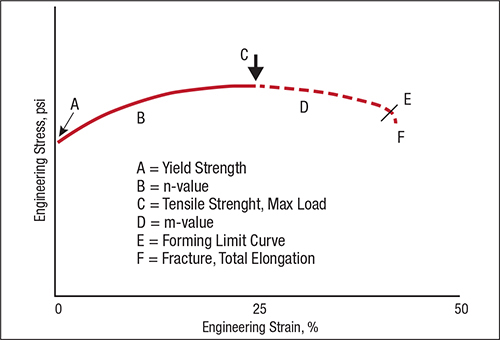In bending angle rings, a stress–strain curve for a material gives the relationship between stress and strain. It is obtained by gradually applying load to a test coupon and measuring the deformation, from which the stress and strain can be determined. These curves reveal many of the properties of a material, such as the Young’s modulus, the yield strength and the ultimate tensile strength.
If tensile force is applied to a steel bar, it will have some elongation. If the force is small enough, the ratio of the stress and strain will remain proportional. Beyond the elastic limit, the mild steel will experience plastic deformation. This starts the yield point – or the rolling point – which is Section B, or the upper yield point. Section C on the stress-strain curve is where we measure ultimate tensile strength, maximum load, uniform elongation and the onset of the diffuse neck. Section D of the stress-strain curve (dashed line in Fig. 1) is important to nonferrous materials such as aluminum and copper alloys. Once the tensile-test specimen initiates the diffuse (width) neck, the stress in the specimen begins to decrease and deformation outside of the neck stops. The speed of forming within the diffuse neck increases to compensate for the loss of deformation in the zones outside the neck.

Midwest Metal Products / AngleRings.com sets the industry standard for adherence to the stress strain curve for manufacturing angle rings in steel, aluminum and other materials. Contact us today for more information on how our angle rings can be manufactured to fulfill any of your project specifications.